
Concept explainers
LO3 LO4 10.
| Year | Cash Flow (A) | Cash Flow (B) |
| 0 | –$78,500 | –$78,500 |
| 1 | 43,000 | 21,000 |
| o | 29,000 | 28,000 |
| 3 | 23,000 | 34,000 |
| 4 | 21,000 | 41,000 |
a. What is the IRR for each of these projects? If you apply the IRR decision rule, which project should the company accept? Is this decision necessarily correct?
b. If the required return is 11 percent, what is the NPV for each of these projects? Which project will you choose if you apply the NPV decision rule?
c. Over what range of discount rates would you choose Project A? Project B? At what discount rate would you be indifferent between these two projects? Explain.
a)
To calculate: The IRR (Internal Rate of Return) for the proposed projects of Company Z, the project that the company must accept and discuss whether the taken decision is appropriate
Introduction:
The IRR (Internal Rate of Return) is a rate of discount which makes the predictable investment’s NPV equal to zero.
The NPV (Net Present Value) is a capital budgeting technique which is used to assess the investment that, in turn, is utilized to identify the profitability in a proposed investment.
Answer to Problem 10QP
As IRR is higher in Project A when compared to Project B, Project A can be accepted. However, it is not the appropriate decision because the criterion of IRR has a problem in ranking for mutually exclusive projects.
Explanation of Solution
Given information:
Company Z has identified two mutually exclusive projects where the cash flows of Project A are $43,000, $29,000, $23,000, and $21,000 for year1, 2, 3, and 4 respectively. The cash flows of Project B are $21,000, $28,000, $34,000, and $41,000 for year 1, 2, 3, and 4 respectively. The initial costs for both the projects are $78,500 respectively.
Note:
- NPV is the difference between the present values of the cash inflows from the present value of cash outflows.
- The IRR is the rate of interest which makes the project’s NPV equal to zero. Hence, using the available information, assume that NPV is equal to zero and form an equation to compute the IRR.
Equation of NPV to compute IRR assuming that NPV is equal to zero:
Compute IRR for Project A using a spreadsheet:
Step 1:

- Type the equation of NPV in H6 in the spreadsheet and consider the IRR value as H7
Step 2:

- Assume the IRR value as 10%
Step 3:
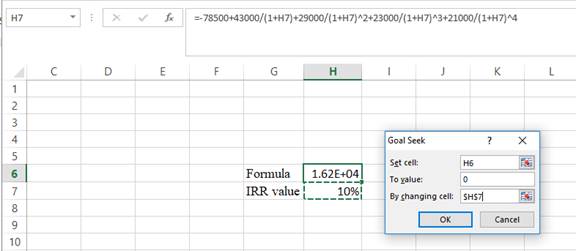
- In the spreadsheet, go to data and select the what-if analysis.
- In the what-if analysis, select goal seek.
- In set cell, select H6 (the formula).
- The “To value” is considered as 0 (the assumption value for NPV).
- The H7 cell is selected for the by changing cell.
Step 4:
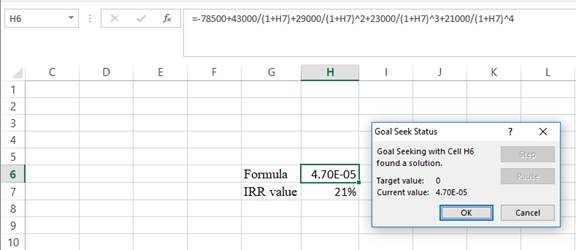
- Following the previous step, click OK in the goal seek. The goal seek status appears with the IRR value.
Step 5:

- The value appears to be 20.7045842372508%.
Hence, the IRR value is 20.70%.
Compute IRR for Project B using a spreadsheet:
Step 1:

- Type the equation of NPV in H6 in the spreadsheet and consider the IRR value as H7.
Step 2:

- Assume the IRR value as 10%.
Step 3:
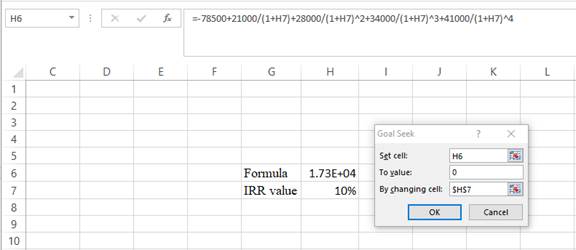
- In the spreadsheet, go to data and select the what-if analysis.
- In the what-if analysis, select goal seek.
- In set cell, select H6 (the formula).
- The “To value” is considered as 0 (the assumption value for NPV).
- The H7 cell is selected for the by changing cell.
Step 4:
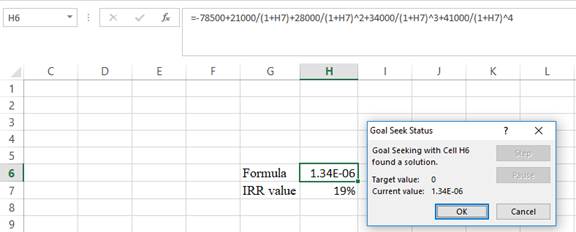
- Following the previous step click OK in the goal seek. The goal seek status appears with the IRR value,
Step 5:
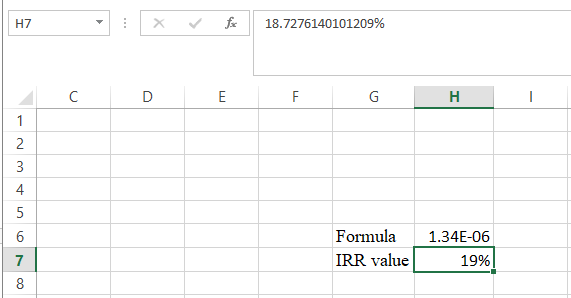
- The value appears to be 18.7276140101209%.
Hence, the IRR value is 18.73%.
b)
To calculate: The NPV for the projects to choose the best project for the company
Introduction:
The IRR (Internal Rate of Return) is a rate of discount which makes the predictable investment’s NPV equal to zero.
The NPV (Net Present Value) is a capital budgeting technique which is used to assess the investment that, in turn, is utilized to identify the profitability in a proposed investment.
Answer to Problem 10QP
As NPV is greater in Project B, the company must accept Project B.
Explanation of Solution
Given information:
Company Z has identified two mutually exclusive projects where the cash flows of Project A are $43,000, $29,000, $23,000, and $21,000 for year1, 2, 3, and 4 respectively. The cash flows of Project B are $21,000, $28,000, $34,000, and $41,000 for year 1, 2, 3, and 4 respectively. The initial costs for both the projects are $78,500 respectively.
Note:
- NPV is the difference between the present values of the cash inflows from the present value of cash outflows.
- The IRR is the rate of interest which makes the project’s NPV equal to zero. Hence, using the available information, assume that NPV is equal to zero and form an equation to compute the IRR.
Formula to calculate the NPV:
Compute NPV for Project A:
Hence, the NPV for Project A is $14,426.54.
Compute NPV for Project B:
Note: The rate is given at 11%.
Hence, the NPV for project B is $15,012.82.
c)
To calculate: The rates of discount at which the company will select Project A and Project B and the discount rate in which the company will be indifferent in selecting between the two projects
Introduction:
The IRR (Internal Rate of Return) is a rate of discount which makes the predictable investment’s NPV equal to zero.
The NPV (Net Present Value) is a capital budgeting technique which is used to assess the investment that, in turn, is utilized to identify the profitability in a proposed investment.
Answer to Problem 10QP
At the rate of discount above 12.21%, the company must choose Project A, and for the rate below 12.21%, the company should choose Project B. Hence, it is indifferent at the discount rate of 12.21%.
Explanation of Solution
Given information:
Company Z has identified two mutually exclusive projects where the cash flows of Project A are $43,000, $29,000, $23,000, and $21,000 for year1, 2, 3, and 4 respectively. The cash flows of Project B are $21,000, $28,000, $34,000, and $41,000 for year 1, 2, 3, and 4 respectively. The initial costs for both the projects are $78,500 respectively.
Note:
- NPV is the difference between the present values of the cash inflows from the present value of cash outflows.
- The IRR is the rate of interest which makes the project’s NPV equal to zero. Hence, using the available information, assume that NPV is equal to zero and form an equation to compute the IRR.
Equation to calculate the crossover rates:
Compute the discount rate using spreadsheet
Step 1:

- Type the equation of NPV in H6 in the spreadsheet and consider the R value as H7.
Step 2:

- Assume the R value as 10%.
Step 3:

- In the spreadsheet, go to data and select the what-if analysis.
- In the what-if analysis, select goal seek.
- In set cell, select H6 (the formula).
- The “To value” is considered as 0 (the assumption value for NPV).
- The H7 cell is selected for the by changing cell.
Step 4:
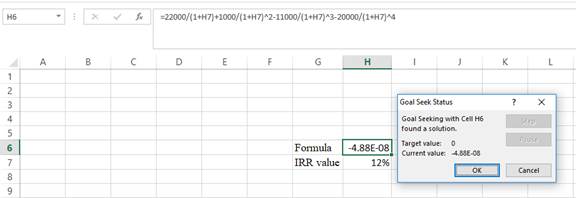
- Following the previous step click OK in the goal seek. The goal seek status appears with the R value.
Step 5:
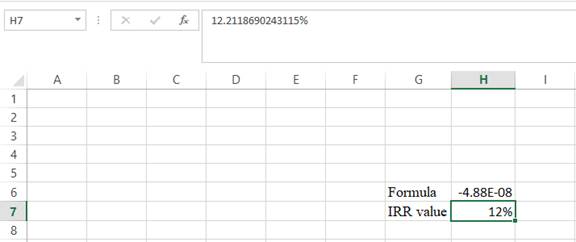
- The value appears to be 12.2118690243115%.
Hence, the R value is 12.21%.
Want to see more full solutions like this?
Chapter 8 Solutions
ESSENTIALS OF CORPORATE FINANCE (LL)
- A3 4e We have two mutually exclusive investments with the following cash flows: Year Investment A Investment B 0 –$100 –$100 1 10 50 2 30 40 3 50 30 4 70 20 e. If the required return on this project is 10%, would both NPV and IRR give us the same conclusion? Explain your answer.arrow_forwardA3 5e 5. We have two independent and mutually exclusive projects, A and B. Project A requires an initial investment of $1500, and will yield $800 of cash inflows for the next three years. Project B requires an initial investment of $5000, and will yield $1,500 of cash inflows for the next five years. The required return on each project is 10%. The cash flows and required return given are all in nominal terms. Given that the inflation rate is 3%, answer the following questions: e. What are the real cash flows from Project A and Project B?arrow_forwardA3 5d 5. We have two independent and mutually exclusive projects, A and B. Project A requires an initial investment of $1500, and will yield $800 of cash inflows for the next three years. Project B requires an initial investment of $5000, and will yield $1,500 of cash inflows for the next five years. The required return on each project is 10%. The cash flows and required return given are all in nominal terms. Given that the inflation rate is 3%, answer the following questions: d. What is the real rate of return based on the exact Fisher equation?arrow_forward
- Here is the cash flow for two mutually exclusive projects. Project C0 C1 C2 C3 A -$20,000 $8,000 $8,000 $8,000 B -$20,000 0 0 $25,000 At what interest rate would you prefer project A to B? ( NPV Value) 2. What is the IRR of each project? Explain you answer using formulas.arrow_forwardPA2. LO 11.2Jasmine Manufacturing is considering a project that will require an initial investment of $52,000 and is expected to generate future cash flows of $10,000 for years 1 through 3, $8,000 for years 4 and 5, and $2,000 for years 6 through 10. What is the payback period for this project?arrow_forwardA3 5b 5. We have two independent and mutually exclusive projects, A and B. Project A requires an initial investment of $1500, and will yield $800 of cash inflows for the next three years. Project B requires an initial investment of $5000, and will yield $1,500 of cash inflows for the next five years. The required return on each project is 10%. b. What is the problem with using the NPV investment criterion in this case? What alternative criterion should be used?arrow_forward
- A3 4d We have two mutually exclusive investments with the following cash flows: Year Investment A Investment B 0 –$100 –$100 1 10 50 2 30 40 3 50 30 4 70 20 d. If the required return on this project is 17%, would both NPV and IRR give us the same conclusion? Explain your answer.arrow_forward17. Consider the following two mutually exclusive projects: Year Cash Flow (A) Cash Flow (B)0 −$291,000 −$41,6001 37,000 20,0002 55,000 17,6003 55,000 17,2004 366,000 14,000 a) What is the Internal Rate of Return (IRR) for each of these projects? b) Using the IRR decision rule, which project should the company accept? c) If the required return is 11 percent, what is the Net Present Value (NV) for each of these projects? d) Using the NPV decision rule, which project should the company accept? e) Why do you think the NPV and IRR rules do not agree on same project approval/rejection direction?arrow_forward8) Modern Refurbishing Inc. is considering a project that has the following cash flow data. What is the project's IRR? Note that a project's IRR can be less than the cost of capital (and even negative), in which case it will be rejected. Year 0 1 2 3 4 Cash flows −$850 $300 $290 $280 $270 a. 15.89% b. 13.13% c. 19.22% d. 17.48% e. 14.44%arrow_forward
- A3 5 f 5. We have two independent and mutually exclusive projects, A and B. Project A requires an initial investment of $1500, and will yield $800 of cash inflows for the next three years. Project B requires an initial investment of $5000, and will yield $1,500 of cash inflows for the next five years. The required return on each project is 10%. The cash flows and required return given are all in nominal terms. Given that the inflation rate is 3%, answer the following questions: f. What are the real net present values of Project A and Project B? (Hint: The real NPV should be the same as the nominal NPV.)arrow_forward4. Strathburn Strathburn is a family-owned company which is reviewing its investment plans; it is currently looking at three projects for which £2 million has been put aside. Project Investment PV of future cashflows Probability £ million £ million X 2.0 7.0 1.0 0.417 0.583 Y 1.0 3.5 0.5 0.5 0.5 Z 1.0 3.0 0 0.5 0.5 These projects are not divisible so the company could either invest in X alone or in Y and Z. Required: Calculate the expected NPV of each of the three projects and conclude whether it would be better to invest in X alone or in Y and Z. Calculate the four possible outcomes for the NPV if Y and Z are undertaken along with their associated probabilities. Calculate the probability of making a negative NPV if X alone is chosen or if Y and Z are chosen; comment on your results.arrow_forward47) Modern Refurbishing Inc. is considering a project that has the following cash flow data. What is the project's IRR? Note that a project's IRR can be less than the cost of capital (and even negative), in which case it will be rejected. Year 0 1 2 3 4 Cash flows −$850 $300 $290 $280 $270 a. 15.89% b. 13.13% c. 19.22% d. 17.48% e. 14.44% 48) Modern Refurbishing Inc. is considering a project that has the following cash flow data. What is the project's IRR? Note that a project's IRR can be less than the cost of capital (and even negative), in which case it will be rejected. Year 0 1 2 3 4 Cash flows −$850 $300 $290 $280 $270 a. 15.89% b. 13.13% c. 19.22% d. 17.48% e. 14.44%arrow_forward
 Essentials Of InvestmentsFinanceISBN:9781260013924Author:Bodie, Zvi, Kane, Alex, MARCUS, Alan J.Publisher:Mcgraw-hill Education,
Essentials Of InvestmentsFinanceISBN:9781260013924Author:Bodie, Zvi, Kane, Alex, MARCUS, Alan J.Publisher:Mcgraw-hill Education,

 Foundations Of FinanceFinanceISBN:9780134897264Author:KEOWN, Arthur J., Martin, John D., PETTY, J. WilliamPublisher:Pearson,
Foundations Of FinanceFinanceISBN:9780134897264Author:KEOWN, Arthur J., Martin, John D., PETTY, J. WilliamPublisher:Pearson, Fundamentals of Financial Management (MindTap Cou...FinanceISBN:9781337395250Author:Eugene F. Brigham, Joel F. HoustonPublisher:Cengage Learning
Fundamentals of Financial Management (MindTap Cou...FinanceISBN:9781337395250Author:Eugene F. Brigham, Joel F. HoustonPublisher:Cengage Learning Corporate Finance (The Mcgraw-hill/Irwin Series i...FinanceISBN:9780077861759Author:Stephen A. Ross Franco Modigliani Professor of Financial Economics Professor, Randolph W Westerfield Robert R. Dockson Deans Chair in Bus. Admin., Jeffrey Jaffe, Bradford D Jordan ProfessorPublisher:McGraw-Hill Education
Corporate Finance (The Mcgraw-hill/Irwin Series i...FinanceISBN:9780077861759Author:Stephen A. Ross Franco Modigliani Professor of Financial Economics Professor, Randolph W Westerfield Robert R. Dockson Deans Chair in Bus. Admin., Jeffrey Jaffe, Bradford D Jordan ProfessorPublisher:McGraw-Hill Education





